You are reading the older HTML site
Positive Feedback
ISSUE
3
ensemble
Masterflux cables, and Mega Power Point, Powerflux and Isolink AC accessories
as reviewed by Larry Cox, Dave Clark, and Francisco Duran
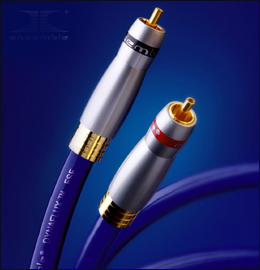
(this review ran in the 2001 Issue 13 of audioMUSINGS)
LARRY COX'S SYSTEM: LOUDSPEAKERS ELECTRONICS SOURCE CABLES ACCESSORIES
|
 I'm a big
fan of Ensemble gear. It has been scarce in the U.S., and in fact for a few years there
was no distribution here, but some time around 1996 I finally got to hear an all-Ensemble
system at a Stereophile show, and it really wowed me. I I heard an amazing demonstration of Linda Ronstadt
singing "What's New?" from the album of the same name. I was so bowled over by the sound that I went back,
not to hear how the system sounded with different music, but to experience the beauty of
that song again. It touched me where it
counted, and I wanted to be touched again.
I'm a big
fan of Ensemble gear. It has been scarce in the U.S., and in fact for a few years there
was no distribution here, but some time around 1996 I finally got to hear an all-Ensemble
system at a Stereophile show, and it really wowed me. I I heard an amazing demonstration of Linda Ronstadt
singing "What's New?" from the album of the same name. I was so bowled over by the sound that I went back,
not to hear how the system sounded with different music, but to experience the beauty of
that song again. It touched me where it
counted, and I wanted to be touched again.
So, here we are in 2001, and Brian Ackerman of Artistic Audio has brought Ensemble back to the States. Hooray! Ensemble, for those that don't know, is Swiss gear built like a tank, with the tolerances, fit, and finish that have made the Swiss renowned. Good to look at, good to use and, I'd speculate, easy to own. When an opportunity to review something from Ensemble came around, I was excited (frankly, not as excited as if it were speakers or an amplifier, but still, it was something from Ensemble). The fit and finish of the Ensemble wire is wonderful. If you are going to have $1700 worth of wiring running through your listening room, it is nice that it looks like it is worth it.
Writing (and reading) about wire is difficult, so I'm going to make it easy for all of us and break it down like this: This stuff is not inexpensive, but it's really a bargain for the level of performance. Depending on how much wiring you need in your system, you could be in for several thousand dollars, but their interconnects at $480 a meter compete with the Quattro Fils from Nordost which retail at $1600 for 0.6 meters, and at one time the Quattro Fils were "the standard" for top performance. What I mean by comparable performance isn't a better-or-worse sort of thing. They are different. The Quattro Fil is more of an audiophile cable, with more detail at the frequency extremes. The Ensemble excels in the parameter of sweetness and liquidity. I found it easier to nestle into music with the Ensemble interconnects. Oh (and this is not entirely unique to Ensemble), the more wire of theirs you use, the more the quality of the cable comes through. The qualities I recall in hearing Linda Ronstadt years ago were brought forth again in my system with the Ensemble wiring. Ultimately, my whole system was swaddled in Ensemble, and at each step toward complete immersion, the closer I got to a sound that positively invited me to the couch and the harder it got to be analytical about what was happening.
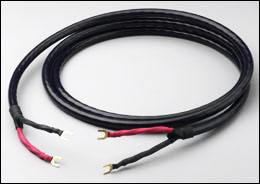
Megaflux
While the interconnects were flexible and a joy to use, the speaker wire was tougher to work with. Not the stiffest stuff under the sun, but stiffer than the Belden cable I've been using. While the Ensemble isn't as easy to use, it sounds better. It acted like a "calming" influence on the sound—less noise, more signal, and a clearer picture of music in the room. Imaging was better than with my Belden or the Audio Quest Midnight 3X it replaced. Again comparing the Ensemble to Nordost (SPM this time), the Ensemble had less decay and perhaps less specific imaging, but way more musicality.
Next came the power cords, and the more Ensemble cords I had in my system, the better it sounded. The noise floor continued to drop, bass became more solid sounding, and while the top end didn't become more highlighted, it became easier to hear into. Since the power cords, interconnects, and speaker wiring all have the same "wire" underneath the jackets, this shouldn't be surprising. The power cords are short and stiff, making them a little difficult to work with. I had power cords arcing around my equipment rack. You'll want to choose your room setup carefully to mitigate unwanted power cord "rainbows." The Isolink is a power conditioner of sorts. Oddly, while you read that power conditioners work best on DACs, Ensemble instructs that the first place to stick the Isolink is on your transport, and THEN your DAC or preamp. I heard more difference using it with my transport than with the Audio Note 1.1 DAC or my E.A.R. 802 preamp. That said, however, I didn't hear a lot of difference. I would purchase the speaker wires, and then the interconnects, before I'd buy the power cords or the Isolink, but that is my system. I certainly could use a better digital front end, which might allow me to hear more. E.A.R.'s U.S. importer, Dan Meinwald, who has a pair of ears I trust (no pun intended), says that the Isolinks really rocked his system. As they say, your mileage may vary.
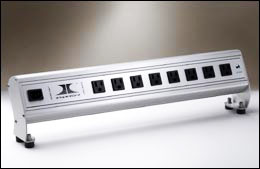
Power Point
The gem of the Ensemble system was perhaps the Mega Power Point power strip. It is simple, elegant, and something you'd be willing, even happy to have lying on your floor. The Mega Power Point allows for six pieces of gear to be plugged into it. At $980, it isn't inexpensive, but I'd probably buy the Mega Power Point and some interconnects before I'd buy the power cords or the Isolink. The noise floor dropped even further, and music became more liquid and sweet. More space appeared within which the music could blossom. The Mega Power Point certainly clobbered my API Power Wedge, though at $980 versus $240, it should. I've made mention throughout this article of what I'd buy first of the Ensemble wiring because I really like this stuff. I would like to have my system entirely wired with it, but cannot afford to. If you can, and you are in the market for wire, all of this stuff is worth a listen, and the more the better. Larry Cox
DAVE CLARK'S SYSTEM: LOUDSPEAKERS ELECTRONICS SOURCES CABLES ACCESSORIES
|
 "You
don't say? That good? You have six of these and they are how much? It really does that in your system? Alright, I'm
interested, I'll try the stuff." This was my end of two conversations with audiophile
friends, Dan Meinwald, the E.A.R. importer, who had heard an Ensemble demo in his system,
and maniac tweaker Kyle Takenaga, a serious Ensemble user. A few days later, in comes a
very large box containing enough AC cords, interconnects, and speaker cables to open a
dealership, plus the highly-touted Isolink isolation transformer and the Power Point AC
distribution thingy. All of this stuff is fairly expensive (though well below the upper
end of the current cable scene), heavy, and ultra-slick. After closely inspecting and
listening to this array of products, I have to say I'm not sure why it costs as much as it
does, but musically it is right up there with the best.
"You
don't say? That good? You have six of these and they are how much? It really does that in your system? Alright, I'm
interested, I'll try the stuff." This was my end of two conversations with audiophile
friends, Dan Meinwald, the E.A.R. importer, who had heard an Ensemble demo in his system,
and maniac tweaker Kyle Takenaga, a serious Ensemble user. A few days later, in comes a
very large box containing enough AC cords, interconnects, and speaker cables to open a
dealership, plus the highly-touted Isolink isolation transformer and the Power Point AC
distribution thingy. All of this stuff is fairly expensive (though well below the upper
end of the current cable scene), heavy, and ultra-slick. After closely inspecting and
listening to this array of products, I have to say I'm not sure why it costs as much as it
does, but musically it is right up there with the best.
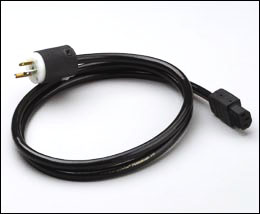
Powerflux
Let me look at each product individually. The Powerflux FSF power cords look as if they are really nothing more than a bundle of wires in a nice molded jacket. They are very well built—they do feature elaborate shielding—but the Powerflux has the outward appearance of mass-produced wire from a spool. Nice plugs and all, but come on, $680 apiece? Yes, they worked well, allowing my components to ever-so-slightly open up and flow musically, but I am not sure that the production costs warrant the asking price. On the other hand, does their performance justify the $680?
Compared to the Sahuaro, Clayton, JPS, and Blue Circle cords I usually use, I would have to say it all depends on what you want your music to sound like—and isn’t that what it is supposed to be about?
Substituting the Powerfluxes for my cords resulted in a somewhat sweeter, more relaxed presentation. But music was also perceptibly softer and more delicate, with a greater degree of "suaveness." Nice, but where’s the excitement? Add to this a now leaner and less warm musical presentation, and I was not hearing what I wanted to from my music. The funny thing, though, was that this pretty much the opposite of what I heard with these cords in Dan's system, and the degree of difference in my system was also considerably smaller. Dan's system became fuller and warmer, with a greater sense of scale. Differences, yes, but not really any improvements that made me want to jump for the checkbook.
I had a similar response to the speaker cable and interconnects. Adding more Ensemble wire wrought more of the same. The music took on such a degree of delicacy that images of sweet little grandmothers sitting in warm sunshine in flower-filled fields sewing fine lace dollies came to mind. Music was very relaxing and enveloping, but not really what I want. The JPS wires impart more life and exuberance and greater "masculinity" to the music. They are more gruff and less "civilized" than the Ensemble wire, but more visceral and involving.
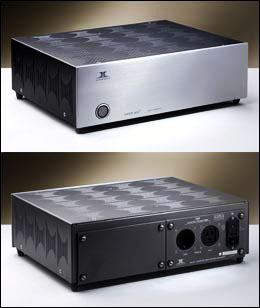
Isolink
The Ensemble wire is good, in fact very good, but whether you will prefer it will be a matter of taste and system interaction. The Isolink is a different beast altogether. At $1760, this is an expensive AC accessory that, with only one female ac plug, visually presents you with an ac outlet for only one component at a time. At least that is the best way I see it being used. While it can handle up to 1000 watts with a nominal load of 600, which is all nice and dandy, what would be the purpose of that? I mean the idea behind an isolation transformer is to isolate components from one another. If I were to run a power strip for the whole system off the Isolink, then anything connected to this strip would contaminate any other component connected to it as well. All I would be doing is isolating the system from the wall, but not from each other. Besides that, the cruel reality is that the more you require a transformer to handle the faster it will run out of steam and compress the music. Even at 1000 watts, compression or limiting of current will occur. So while the Isolink can feed the Power Point AC strip, I choose to use it as was recommended by Kyle and Dan—let it work on only one component.
So $1760 per component means that if you want to plug in, say, a transport, a DAC, and a preamp, it'll cost you $5280!!! And that's without the three extra power cords required! And Kyle has six of these, allowing him to isolate all his gear from each other with no compression. The costs can add up really quickly, which is not to say that there aren't other products that cost more and do less. I tried the Isolink with my transport, substituting it for my homebrewed AC filtration unit (Corcom filters for each duplex, star-wired with Harmonic Technology wire, wrapped in Cable Jackets, all in a very tweaky box—this being before the addition of the Audio Magic Stealths and PS Audio P300 unit). I also have two dedicated AC lines, and apparently I am blessed with about 126 volts on a regular basis, but adding the Isolink resulted in greater clarity, transparency, and openness to the music. It wasn't jaw-dropping, but it was noticeable.
Better, but not worth $1760, at least not here. At Dan's, the differences were of such a degree that he bought one and has another on the way, but he also has terrible AC wiring. I shared my results with Kyle (who obviously finds the Isolinks to be of great benefit), and he felt that a better transport would react more positively than my EAD transport. That seems a bit counterintuitive, though it is true that both Dan and Kyle have very good digital front ends. On the other hand, both have less than ideal AC flowing into their homes, so my conclusion is that power delivery is the critical issue. All I can say is, there was an improvement but not a drastic one. I suppose if I were to win the lottery I would have one on each component. I didn't say it didn't work, just that the improvements in my system were not worth the money, given my finances.
The Power Point is a six-outlet AC strip using the Ensemble Powerflux cable to connect everything together. At $980, this has to be of the more expensive power strips on the market. It is very well made, but when I plugged everything into it versus my own unit, the differences were very small. I guess my unit is pretty good, or perhaps due to the quality of my ac, neither unit really does much at all. With the Power Point in the chain, you do get the benefit of the Ensemble sound. Music was a touch sweeter and more delicate, so perhaps it was not a complete wash. It was doing something positive, and it does give you the benefit of allowing your components to "see" the Powerflux effect without having to buy a bucket load of AC cables. Is it worth $980? If you need a power strip and want a good one, this may be it.
When I finally installed all of the Ensemble products, including the Isolink and the Powerflux, the effect was very enjoyable, though not musically where I want to be all the time. As I said before, the more Ensemble products you have, the more effect they have. It's kind'a like sugar. The more you add, the sweeter it gets. I don't like my music that sweet, but you may. Dave Clark
FRANCISCO DURAN'S SYSTEM: LOUDSPEAKERS ELECTRONICS SOURCE CABLES ACCESSORIES
|
 I
was interested to get the Ensemble wires into my system, as I hadn’t tried any
different wire since buying my JPS stuff. For one thing, compared to my two thin runs of
JPS Ultraconductor speaker cable, the Ensemble Megaflux is very thick and somewhat stiff,
causing some fear of launching my speakers off of their stands, or of breaking a connector
on my little amps. When I first started out in this hobby, I thought nothing of risking
life, limb, equipment, or pocketbook for good sound, but no more. I have become a saner,
more reasonable gearhead. I am glad to say that nothing happened to my equipment during
the course of listening to the Ensemble wire.
I
was interested to get the Ensemble wires into my system, as I hadn’t tried any
different wire since buying my JPS stuff. For one thing, compared to my two thin runs of
JPS Ultraconductor speaker cable, the Ensemble Megaflux is very thick and somewhat stiff,
causing some fear of launching my speakers off of their stands, or of breaking a connector
on my little amps. When I first started out in this hobby, I thought nothing of risking
life, limb, equipment, or pocketbook for good sound, but no more. I have become a saner,
more reasonable gearhead. I am glad to say that nothing happened to my equipment during
the course of listening to the Ensemble wire.
So, bravely hooking up the Ensemble Megaflux speaker wire, I was treated to a nice surprise. This wire is very transparent, with an open, smooth, detailed, and dynamic sound. There seemed to be no coloration at all. This was apparent with a couple of re-mastered Steely Dan CDs. The sound was slightly less warm than with my own speaker wire. It was also a tad more open and neutral, with a more transparent soundstage. The JPS sounded a tad more sweet and round. The JPS exhibits no harshness, and it is nicely detailed, yet it is slightly darker than the Ensemble wire. Although the Megaflux cables were somewhat bulky, they let the music through. Next I replaced all of my JPS Superconductor+ interconnects with Ensemble’s Masterflux interconnects. At about $460 a pair, these guys won’t really break the bank, nor did they disappoint. They had a sound similar to that of the speaker cables. They sounded grainless and dynamic, with a lack of coloration. Steely Dan came across very cleanly, with less background noise. The sax, chimes, and piano on John Klemmers’ CD on Mo Fi sounded sweet and detailed. Of course I had to spin some Taj Mahal, and I noticed a very clean and extended top end.
Cymbal strikes had a real fullness to their shimmer, but they were not bright. Taj’s vocals were very apparent without being obvious or exaggerated. I also heard full, deep bass. The tuba on Taj’s live album sounded fat and textured, yet the bass guitar on the Steely Dan albums was fast and taut. Other goodies sent to us with the Ensemble wire included the Isolink isolation transformer and the Mega Power Point. The Isolink, a small, rectangular, single box with a single outlet, weighs a hefty 26 pounds and has a price tag of $1760, so Isolinking your whole system could cost you some cash. I hooked my CD player up to it, thinking that would have the most benefit, and I was not disappointed. The Isolink fleshed out music in a natural manner, with instruments and vocals having a less artificial sound. On Lee Ritenour and Larry Carlton’s Larry and Lee CD, and also on Ritenour’s Wes Bound, the Isolink’s benefits really kicked in. I noticed an opening up of the soundstage, with a depth and air that brought you closer to the real thing.
This little silver box lets you into the recording in a way that I have not previously experienced. Dynamics also opened up, expanding without sounding hi-fi. Music is more layered and dimensional, but somehow these don’t seem to be the right words. "Naturally placed in space" is more like it. When I pulled the Isolink out of my system to hear the difference, I was immediately disappointed. Suddenly a noticeable portion of the soundstage was gone. The music sounded a little less dynamic and more flattened out.
I tried the Richard Grey Power Company Model S400 Power Enhance and Surge Suppressor and my own Brickwall Surge Suppressor for comparison. Similar results were obtained with the RGPC. The soundstage was a tad darker, and not quite as open, but it was a close call. The Brickwall filter gave very good soundstaging and air. The dynamics were intact and the music took on a delicate sweetness. I thought that the Brickwall’s performance came uncomfortably close to the Isolink’s, especially considering the price difference, but the Isolink had the edge over the other two products when it came to reproducing the air and space in a recording.
It has a way of letting you into a recording and relaxing you into the music that is uncanny. Once you hear it, you’re hooked. The Isolink is expensive but worth every penny. The Mega Power Point is a six-outlet AC distribution strip built with Mega wiring and a Mega Powerflux power cord. This is by no means a plain old power strip. It replaced my Brickwall unit and handled all the distribution of power to my components with ease. All aspects of sound reproduction that I usually hear in my system were passed through without any hiccups or alteration.
The real kickers for me, though, were the Mega Powerflux power cords. The fact that these cords were much better than the ones that I own was plainly obvious in seconds. Most of the time for me, changing a power cord is like changing your pants or shoes. There are small improvements here or there, but most high end power cords seem to be different, not better. The Mega Powerflux cords make the music sound noticeably more open, powerful, and dynamic as soon as you press play. These cords, like the Ensemble speaker cables, are quite unwieldy. If they were a little more flexible, I would definitely consider them for my system. As they are, I feared for the life of my Brickwall filters. With the massive Isolink and Mega Power Point, though, I had no such fears.
These wires and gear worked very well in my system, and unless you wanted to add about six or seven of the Isolinks, I really don’t think the cost is unreasonable considering the performance. I would spend my money a lot faster on the Masterflux interconnects or the Mega Powerflux power cords than on other comparably priced wire I can think of. While I was listening to all of the music that I played through the Ensemble wire, the thought that kept coming to mind was that this was the sound that the musicians and sound engineers were trying to get. Was I just wishfully daydreaming, or is it that the Ensemble wire gets out of the way and lets more of the music through? Francisco Madrid
Ensemble
web address: www.aaudio.com
